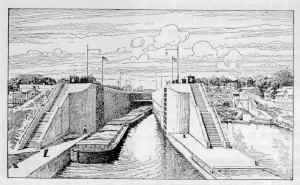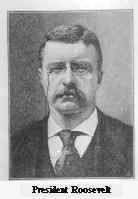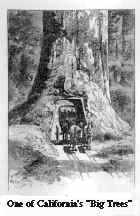Resource Center OLLibrary
|
394 |
|
[1905 |
a hundred years before, we more than doubled the area of our
country by the acquisition of the Louisiana territory
(§§ 215, 216). It showed the marvelous growth of that
part of the great West lying between the Mississippi and the Rocky
Mountains.
The year following (1905) Portland, Oregon,
opened an exposition, which proved a great success. It celebrated
not only the Lewis and Clark Centennial (§ 216), but one of
the most interesting of the "heroic periods" in the history of
that part of the United States west of the Rocky Mountains.
429. Summary. The chief events of the
administrations of Presidents McKinley and Roosevelt (1897-1905)
were (1) the enactment of the Dingley high protective tariff; (2)
the war with Spain; the annexation of Hawaii, Porto Rico, and the
Philippines; (3) the wonderful agricultural progress of the
country west of the Mississippi River; (4) the growth of national
wealth and of gifts for the public good; (5) our action in regard
to the Panama Canal;. (6) the assassination of President McKinley;
(7) the Louisiana Purchase Exposition.
430. Roosevelt's Administration
(Twenty-seventh President, One Term, 1905-1909); Some Things
Americans are doing in the Twentieth Century; how Disasters are
met. In his inaugural address President Roosevelt said there
are two things that we should all resolve to do: first, to keep
whatever is good in our native land unwasted and unharmed;
secondly, to make that good still better, for the sake of those
who are coming after us. There were many who heard the President's
earnest words who could truthfully answer, That is what we have
been trying to do.
I. We work to save time -- "the stuff," as
Franklin said "of which life is made."
1 Born in New York,
1858 (§ 417, note 1); elected Vice President, 1900; became
President, 1901; awarded the Nobel Peace Prize, $40,000, 1906,
with which he endowed the Foundation for the Promotion of
Industrial Peace; but as no way was found for using the money for
that purpose it was eventually returned to him. Elected President
by the Republicans, 1904, over Alton B. Parker,
Democrat.
|
1905-] |
|
395 |
|
Our American steam shovels (see p.
390) were then cutting a passage for ships across the
Isthmus of Panama. This would make the voyage from New
York to San Francisco 8000 miles shorter than that around
South America. |
|
396 |
|
[1905- |
About sixty years ago New York planned the
first great pleasure ground in this country and named it Central
Park. To-day every leading American city has one or more such open
spaces, including playgrounds for children and ball grounds where
all can freely enjoy fresh air and sunshine.
We have laid out national parks on a generous
scale. They will preserve some of the grandest mountain, river,
lake, and forest scenery in the world. We have one such park in
the Yosemite1 Valley in California, another in the
valley of the Yellowstone

BARGES IN THE NEW YORK STATE CANAL
River in Wyoming, a third at Mt. Rainier2 in
Washington, a fourth at Crater Lake in Oregon, a fifth, of lakes
and glaciers,3 in Montana, a sixth in Oklahoma, and a
seventh in Colorado. These, with the Big Tree Parks in California,
cover a space more than double that of Rhode Island and Delaware
combined.
Recently the national government has recommended
that we make a national park of the Grand Canyon of the Colorado
River in Arizona (see p. 25). It is furthermore hoped that our
half
1 Yosemite
(yo-sem'i-tee).
2 Rainier (ray-neer').
3 The glacier, (glay'shers) are vast
fields of ice which slowly creep down the sides of snow-capped
mountains.
|
1905-1908] |
|
397 |
|
of Niagara Falls may be preserved. Then both will
become the common property of American citizens for all
time. |
|
398 |
|
[1905-1908 |
the meeting was the most important one of the kind ever held in
the history of our country. Great good ought to come from it to us
all.
4. But going beyond these things, we are
beginning to try to save the wear and tear of human life. Not very
much has been done in this direction yet, but we look forward with
hopeful hearts. We believe that the time will come when we shall
be able to settle all labor disputes in a friendly way. Then
strikes and lockouts will practically cease. Better work will be
done and better results obtained.
Last of all, we are trying and shall continue
trying to determine what can be done to save the needless
destruction of human life by foolish and hasty wars. For,
notwithstanding all our progress, by far the greater part of our
enormous national revenue is still spent either in preparation for
war or for carrying on war, or in discharging debts and pensions
incurred in our past wars.1 But we find that there is
another side to the picture, for it seems probable that never
before in the history of the world have there been so many wise
and thoughtful men resolved to do all in their power to hold back
nations from unnecessary fighting.
We can truthfully say that, in the main, the
influence of America has been on the side of peace. Our record in
the peaceable settlement of our disputes with other nations shows
that fact (§§ 374, 400, 424). It was also in accordance
with this principle that President Roosevelt (1905) persuaded
Japan and Russia to end their terrible war. In the same year the
United States made treaties or agreements with Mexico and a number
of the republics of Central America and of South America, which
may prevent many useless quarrels. Then (1907-1908) six more
similar treaties were made with England, France, Italy, Spain,
Switzerland, and Portugal.
In these four ways we Americans have resolved to
try to save time, health, the good earth on which we live, and
human life.
1 Total ordinary
expenditures of the national government for 1907 were over
$578,000,000; of this amount over $363,000,000 was spent on the
army, the navy, pensions, and payment of interest on the national
war debt. Since the government was established in 1789 we had
spent more than $15,000,000,000 on war and less than
$5,000,000,000 in other ways; now we must add at least
$25,000,000,000 for our expenses in the Great War (1917-1918), and
some estimates would put the amount far higher.
|
1905-1908] |
|
399 |
There are more than 20,000,000 children in our public schools,
who, we hope, will grow up to take part in this beneficent
work.
But other events show that Americans have begun
developing a different kind of power. They are manifesting their
ability to face and overcome widespread disasters and business
panics.
Reference has been made (§ 372) to the
conflagrations which occurred, in Chicago (1871) and in Boston
(1872) and to the Charleston earthquake (1886). These calamities
were followed by the Galveston hurricane (1900), which destroyed
more than 6000 lives and property valued at $18,000,000, and which
swept away much of the very ground on which the city stood. Four
years later (1904) the great Baltimore fire burned up property
worth upwards of $50,000,000. In all these cases the citizens have
more than made good the devastation, and the rapidly growing port
of Galveston has completed a gigantic sea wall to protect the new
city for the future.
Two years later (1906) came a still heavier
blow. The California earthquake wrought havoc far beyond anything
the country had ever before experienced. Its destructive force
showed itself on the greatest scale at San Francisco, where scores
of costly buildings were overthrown. Fire completed the work of
devastation. More than 200,000 persons were rendered homeless, and
property valued at more than $400,000,000 was destroyed.
The whole population of the United States rose
to send aid to the stricken city. It was a demonstration of the
fact that with us North, South, East, and West form but one
country and one people, and that the blow which strikes the
remotest part is felt by all.
On the other hand, the inhabitants of San
Francisco showed their wonderful power of self-help. They proved
what Americans have proved more than once, that is, that strength
of heart and strength of will can find ways to turn loss into
gain. Standing in the midst of confusion and desolation, they set
their hands to the work, and above the ruins and the ashes of
their old home they have built a new and grander city.
In the same spirit the business men of our
entire country met the money panic (§§ 275, 312, 373,
400) of a later date (1907).
 and
enlarging the Erie Canal, now called the New York State
Barge Canal. That great work was completed in 1917. It is
hoped that before long barges, moved by steam or other
power, will go from Buffalo to New York City in three
days -- or much less than half the time that the old
boats used to take. They can bring millions of bushels of
grain from the West 1 at very low rates. This
should make bread cheaper in the eastern states and in
Europe.
and
enlarging the Erie Canal, now called the New York State
Barge Canal. That great work was completed in 1917. It is
hoped that before long barges, moved by steam or other
power, will go from Buffalo to New York City in three
days -- or much less than half the time that the old
boats used to take. They can bring millions of bushels of
grain from the West 1 at very low rates. This
should make bread cheaper in the eastern states and in
Europe. 3.
We are taking steps to save our farming and pasture land,
our forests, our coal and iron mines, our quarries, our
oil fields, our natural gas, and the water courses of our
country, so that they shall be protected against needless
waste; we are reclaiming vast areas of desert regions by
careful irrigation (see p. 386), and we are beginning to
reclaim extensive marshes by drainage. The government at
Washington employs a number of trained men who devote
their whole time to this most important work.
3.
We are taking steps to save our farming and pasture land,
our forests, our coal and iron mines, our quarries, our
oil fields, our natural gas, and the water courses of our
country, so that they shall be protected against needless
waste; we are reclaiming vast areas of desert regions by
careful irrigation (see p. 386), and we are beginning to
reclaim extensive marshes by drainage. The government at
Washington employs a number of trained men who devote
their whole time to this most important work.


